High Tunnel Grapes: Pest Management
By Mike Brown, Arkansas Cooperative Extension Service; Dr. Jackie Lee, Arkansas Cooperative Extension Service; Dr. Elena Garcia, University of Arkansas; and Luke Freeman, NCAT Specialist
Abstract
This publication is the fourth in a series on high tunnel grape production, based on research led by Dr. Elena Garcia at the University of Arkansas. This publication covers general guidelines for integrated pest management (IPM) of high tunnel grapes, methods of scouting for pests, descriptions and controls for the most important diseases and insect pests, and an example spray schedule for both conventional and organic production of grapes in high tunnels.
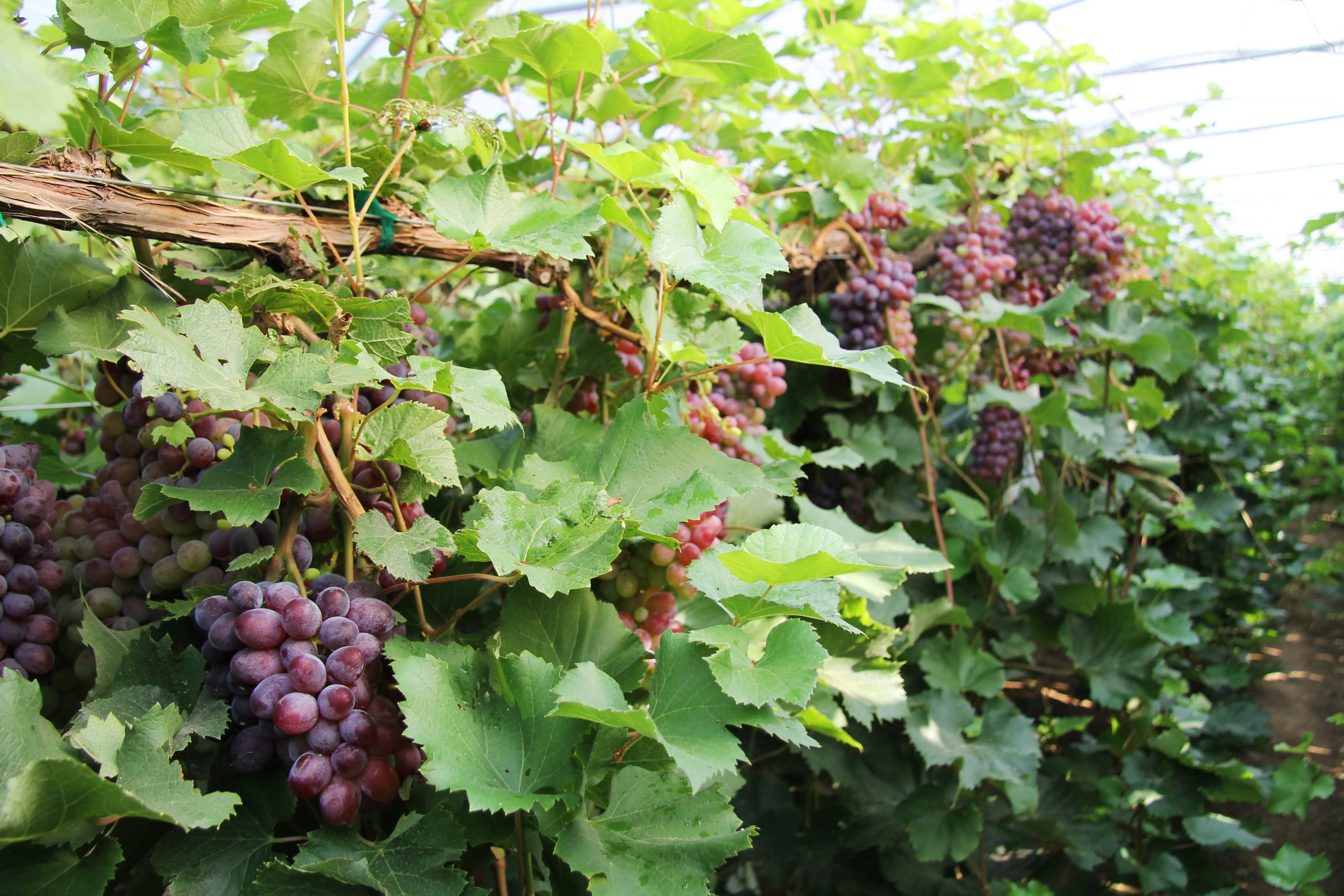
Table grapes in the research high tunnel in Fayetteville, Arkansas. Photo: Luke Freeman, NCAT
Introduction
High tunnels have several inherent advantages over open vineyards, such as allowing the exclusion of certain insect pests and reducing the rain-splashed dispersal of pathogens. However, pest management of grapes in the high tunnel is still a critical component of successful production. This publication approaches grape pest management through the lens of Integrated Pest Management (IPM), which is relevant for both conventional and organic growers. IPM emphasizes cultural and management practices that can reduce insect and disease pressure before resorting to sprays.
For high tunnel grapes, it is important to scout diligently for pests and diseases and take appropriate action when needed. This publication will describe preventative measures for pest management, introduce the most common disease and insect pests, describe methods of control, and present resources for further learning.

Landscape fabric is used in the grape high tunnel to help control weeds. Photo: Luke Freeman, NCAT
General Pest Management Guidelines
Integrated Pest Management (IPM) takes advantage of all available strategies for pest control and strives to reduce pesticide applications whenever possible. Below are important IPM principles for high tunnel grapes, grouped into the categories of prevention, monitoring, and control:
Prevention, Sanitation,and Exclusion
- Manage weeds and wild grapes in and around the high tunnel to reduce alternative hosts for grape diseases and overwintering sites for insect pests.
- Plant only certified disease-free vines to reduce pest issues.
- Avoid excessive fertilization (notably nitrogen) that can lead to an overly dense canopy, which can increase humidity and leaf wetness.
- Remove and destroy material pruned from the grapevines, especially diseased tissue.
- Whenever possible, sanitize pruning tools between cuts to reduce the spread of disease, especially when there is a known disease problem.
- Utilize insect netting or screen to block access to the high tunnel by insects, and use landscape fabric on the ground to control weeds and reduce accumulation of organic material.
Monitoring, Scouting, and Documentation
- Pest issues are easier to manage when noticed as early as possible. Simply walking through the tunnel on a regular basis, looking for signs and symptoms of disease or insect presence, will go a long way toward reducing major pest outbreaks.
- Pheromone lures and sticky cards are available for some pests that are not easily noticed by simple observation. These lures can also be placed away from the high tunnel, especially near unmaintained areas, to get an early warning about the presence of pests before they reach the high tunnel.
- Develop a management plan that suits your particular situation. Take detailed notes about pest issues encountered and what was done to remedy them. Were the measures that were taken successful? Which methods worked well and which ones did not? All these details can help modify and improve the management plan in the future.
Control
- Despite the best efforts, it is often not possible to control pests completely through prevention alone. Both conventional and organic chemical options are available for use in the high tunnel (see the Example Spray Schedule at the end of this publication).
- Many fungicides are preventive and not curative, meaning they need to be applied before disease is visible or established.
- Cultural management techniques, such as pruning vines and removing leaves close to the developing clusters, can greatly improve spray penetration and effectiveness.
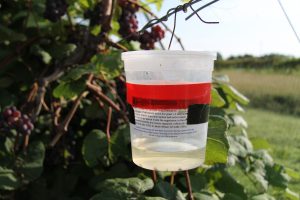
A trap for monitoring Spotting Wing Drosophila in the grape high tunnel in Fayetteville, Arkansas. Photo: Luke Freeman, NCAT
Scouting for Pests
Scouting is an important task in grape management. It is important to scout your planting at regular intervals—generally at least twice a week. When you scout, make sure to look at leaves, shoots, trunks, and fruit. You may need a hand lens to examine leaves closely. Many insect pests, such as mites, can be difficult to see without magnification. You will also need to examine the underside of leaves for pests like aphids and mites. You can purchase traps and bait them with a pheromone lure to monitor grape berry moth, which will help determine if the pest is present and help you schedule appropriate spray timings. There are great resources available online to help diagnose issues, which you can find in the resources section below. We recommend contacting your county Extension office for diagnostic help when needed. Diseases and insect pests to look for while scouting are outlined below.
Important Diseases of High Tunnel Grapes
High tunnels can help reduce the incidence of several common grape diseases by modifying the environment. Because high tunnels are covered by a layer of plastic, rain splash and leaf wetness are minimized; both are important factors in disease development. Lowering the sides of the high tunnel will increase these benefits, but as temperatures rise, the sides and ends of the high tunnel will need to be opened to release heat and humidity and increase air flow. With the sides raised, there is a greater possibility of wind-blown rain entering the tunnel, especially impacting the outer rows. Condensation can form when humidity is high, collecting on the inside surface of the plastic and dripping down onto the plants, increasing leaf wetness. High tunnels have many benefits for crop production, but they are not a cure-all for disease issues. In most cases, a preventative fungicide program will be required for high tunnel grape production.
Anthracnose
Anthracnose is a widespread problem in outdoor vineyards, but high tunnels may limit incidence of anthracnose by reducing rain splash, which is the primary means of spore dispersal. The disease is favored by warm and humid climates. Once established, it can be very difficult to manage, resulting in significant yield loss and a reduction in fruit quality. Fungal spores overwinter on infected canes or berries and spread to young, succulent shoots and berries after germinating in the spring. Initially appearing as small reddish spots, it later progresses to brownish lesions with gray centers and dark margins. Older lesions may fall out, resulting in a “shot hole” appearance, or coalesce into large patches, giving the leaves a deformed look.
Anthracnose management starts with proper vineyard sanitation, so removing infected canes and berries should be the first step. If infected berries are too numerous to remove completely, burying by cultivation or mulching can also be successful. When sanitation is not sufficient for control, fungicide applications can help reduce disease problems. A delayed-dormant application of lime sulfur or copper product shortly before bud-break is critical for control in many systems. Foliar fungicides applied on a seven- to 14-day interval are also recommended during the growing season (Brannen and Cline, 2019; Smith et al., 2020).
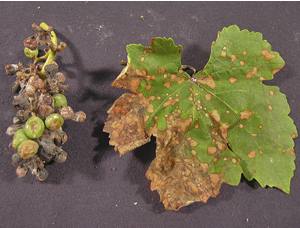
Black rot on grape leaf and fruit. Photo: Sherrie Smith, University of Arkansas Cooperative Extension Service
Black Rot
Black rot is favored by warm, humid weather and can cause heavy yield loss when not adequately controlled. Most cultivated varieties of V. vinifera are highly susceptible to black rot. Symptoms usually first appear as light tan lesions with darker margins on the upper surface of the leaves, progressing to a darker reddish-brown as they develop. Small, black, fungal fruiting bodies called pycnidia form in the lesions and can often be seen with the naked eye or a small hand lens. Infected berries quickly become necrotic, turn a purplish-brown color, and shrivel into a dark mummy that remains tightly attached to the grape cluster. These infected berries produce secondary inoculum, which can quickly spread the disease to entire clusters. Mummies left attached to the vines—or on the ground beneath the vines—serve as the primary source for reinfection in subsequent years (Ellis and Nita, no date).
Black rot management should begin with good sanitation. Removing infected mummies and canes after harvest or during pruning can greatly increase the success of a control program, as mummies left in the grape canopy will be near in proximity to next year’s fruit. In organic production, removal or mulching to cover the mummies left on the ground is an effective strategy to reduce disease incidence. In a conventional system, fungicide applications should be concentrated from immediately before bloom to about four to six weeks post-bloom. This is the time period when the developing fruit is most susceptible to infection (Brannen and Cline, 2019; Smith et al., 2020).

Gray mold on ripe grapes. Photo: University of Georgia Plant Pathology
Botrytis Bunch Rot/Gray Mold
Botrytis bunch rot, also known as gray mold, can cause severe loss by reducing both yield and quality. Most yield loss is due to berry rot, which often requires time-intensive sorting and results in losses during storage and shipping. Tolerance for bunch rot by consumers is low, and the pathogen’s ability to survive at refrigeration temperatures can result in entire crops being rejected. Botrytis has an extensive host range, including other food crops, as well as many weed species found in and around the vineyard. Considering this fact, growers should assume that spores are always present in the environment. Bunch rot usually requires some form of injured or necrotic tissue to initiate an infection, but, once the rot has become established, it can quickly spread to healthy clusters. High levels of humidity and lack of air movement in a high tunnel can exacerbate the problem. Even if bunch rot is not apparent at harvest, the fungus can remain latent on the fruit, undetected, and cause damage during storage, especially if the fruit is handled carelessly.
Every effort should be made to reduce damage to developing fruit, as wounds created by birds, insects, wind-blown debris, or other diseases provide entry points for infection. Tight-clustered varieties are at a higher risk, because berries may rupture as they swell and ripen. When planting new vines, consider cultivars that are less susceptible to bunch rot and orient and space the vines to maximize air movement. Leaf thinning around clusters can help reduce humidity and drying time, due to increased light penetration, as well as maximizing fungicide spray coverage (Wilcox et al., 2015).

Downy mildew on grape leaf. Photo: Sherrie Smith, University of Arkansas Cooperative Extension Service
Downy Mildew
Downy mildew can cause severe defoliation and crop loss. It is often noted as the most damaging disease of grapes in regions with warm and humid climates. Although all green, actively growing parts of the vine are susceptible to downy mildew, symptoms are usually first noted on the upper surface of the leaves, where circular lesions form, taking on a yellowish, or “oil spot” appearance. After later turning necrotic, the lesions become more angular, with a reddish-brown coloration. White, cottony sporulation of the pathogen may be observed on the lower leaf surfaces, opposite these lesions, when humidity levels are high. This sporulation can spread the disease to entire clusters that are developing. Downy mildew spores overwinter in leaf litter and in the top layer of soil under the vines (Wilcox et al., 2015).
Practices that reduce periods of leaf wetness are a practical first step in controlling downy mildew. The pathogen is technically an oomycete (formerly fungus-like organism) and not a fungus, which means that it releases swimming zoospores that require free water to infect the plant tissue. Removing foliage low on the vines, especially that which has direct contact with the soil, can reduce infection from rain splash or zoospores present in the soil. Due to high levels of susceptibility in most cultivars, fungicide applications will often be required in warm and humid climates.
Powdery Mildew
Powdery mildew can be particularly difficult to control for a variety of reasons, including its ability to spread quickly, even under dry conditions, and a relative lack of resistance in available cultivars. All green portions of the grape vine can be infected, but powdery mildew is usually most conspicuous on the leaves, giving them a powdery appearance. When the lower surface of a leaf is infected, chlorotic areas are often seen on the upper surface, and these can produce symptoms similar to early downy mildew infection. Heavily infected leaves may die and fall from the vines. When heavy infection occurs on fruits, the outer skin of the berries cannot expand fully, causing them to split and dry out or become infected by other pathogens.
Pruning to allow maximum air movement and sunlight penetration near the developing clusters is an effective method to decrease disease severity. Most grape cultivars are highly susceptible to powdery mildew, though, so fungicide applications beginning early in the growing season at the first sign of disease are an effective means of control (Brannen and Cline, 2019; Smith et al., 2020).
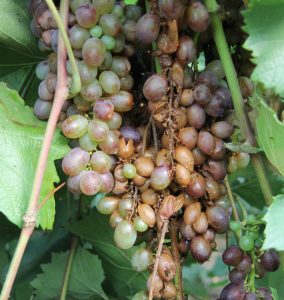
Sour rot on ‘Faith’ table grapes. Photo: Luke Freeman, NCAT
Sour Rot
Sour rot is a disease complex caused by a combination of fungi, yeast, and bacteria that can significantly damage yields. When affected, grapes become soft, watery, and can have a strong vinegar smell. The disease often begins by infecting grapes that have been previously damaged by pests like insects or birds, but grapes that have split or burst due to tight clustering or overwatering can also serve as an initiation point for sour rot (Smith, 2019). Once individual grapes are infected, the disease can spread within entire clusters, causing heavy losses.
Sour rot development is favored by the hot and humid conditions that are often encountered in high tunnels, which makes proper ventilation even more crucial. Cultural practices like canopy thinning and cluster thinning can reduce humidity by increasing air flow through the vines. This also allows better sunlight penetration, which reduces the drying time of clusters and surrounding leaves. Excluding pests and choosing cultivars with less-tight clusters can also help reduce the incidence of sour rot by reducing fruit damage and cracking. Finally, proper harvest timing is important, as overripe grapes are more susceptible to sour rot, and the longer the grapes are left in the tunnel, the greater the opportunity for infection. Fungicides are not effective for sour rot control, reinforcing the importance of proper cultural management.
Disease Management Resources
Arkansas Small Fruit Management Schedule 2023, from the University of Arkansas System Division of Agriculture.
2019 Southeast Regional Bunch Grape Integrated Management Guide, produced by the Southern Region Small Fruit Consortium.
Midwest Fruit Pest Management Guide 2021-22, developed by the Midwest Fruit Workers Group and available from the Purdue Extension Education Store.
Organic Small Fruit Disease Management Guidelines: Integrated Management of Grape Diseases, from the Ohio State University Fruit Disease Resources website.
Important Insect Pests of High Tunnel Grapes
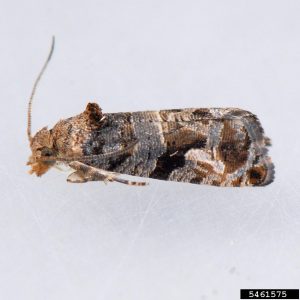
Grape berry moth adult. Photo: Mark Dreiling, Bugwood.org
Grape Berry Moth
The grape berry moth (GBM) is likely the most damaging insect pest of grape production in the southeastern United States. Pupae of the GBM overwinter inside folded grape leaves within the high tunnel and on wild grapes growing nearby. These pupae emerge in spring as adult moths and disperse to lay eggs (Johnson et al., 2003). This makes vineyards located close to unmanaged areas that may harbor wild grapes especially vulnerable. The first-generation larvae feed mainly externally, creating webbing and some shriveling of berries. Subsequent generations tunnel into the pea-size (1/4-inch) or larger grapes to feed, causing widespread rot within clusters by providing an entry point for various pathogens, such as Botrytis bunch rot (Michigan State University, no date).
Controlling weeds under the vines and on the edges of the vineyard can make it easier to remove fallen leaves that may harbor GBM larvae. Removal of wild grapes in the vicinity of the tunnel may be challenging, but will help reduce potential reservoirs for GBM. Vine growth is vigorous in high tunnels, so in-season pruning and canopy thinning can greatly improve the effectiveness of insecticide applications by allowing for better spray coverage.
Monitoring for adult moths in mid to late spring using pheromone traps is recommended, initially focusing on high-risk locations on the edge of the vineyard. When GBM begins to show up in traps, a degree-day model can be utilized to start weekly scouting of clusters for first larval entry in to berries (Saunders et al., 2013; Johnson, 2015). This allows proper timing of insecticide applications to coincide with each GBM hatch. The number of generations per year and degree-day spray intervals will vary based on location and climate, so using local recommendations is critical (see Further Resources). Insecticides like Intrepid 2F® are effective against GBM and a number of other grape pests. Biological sprays such as Bacillus thuringiensis (Bt) can also be effective in organic systems (Smith et al., 2020).
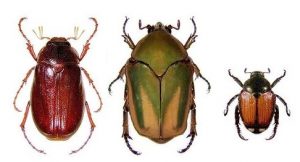
Comparison between May/June beetle, green June beetle, and Japanese beetle (left to right). Photo: Mike Reding and Betsy Anderson, USDA Agricultural Research Service, bugwood.org
Japanese Beetle
The Japanese beetle is a medium-sized (~1/2 in.) metallic green/copper-colored insect that feeds on a wide variety of crops and landscape plants, with grape leaves and clusters being one of its preferred hosts (Johnson et al., 2003). Beetles can first appear anytime from late June into August, but populations usually peak in July. They tend to congregate together in the upper canopy and can quickly defoliate leaves, giving them a skeletonized appearance. Yield loss is negligible unless feeding damage exceeds 15% of the leaf canopy, so treatment is not recommended unless heavy feeding is occurring (University of Illinois Extension and Outreach, no date).
Japanese beetles and green June beetles are large and easy to identify flying into the high tunnel from late June through early August, so monitoring with traps is usually not necessary. If damage is occurring, spot treatment is usually sufficient, if applied before the infestation becomes widespread, but multiple applications may be necessary if beetles continue to invade from surrounding areas. Control is usually with a pyrethroid insecticide, with pyrethrin sprays (such as PyGanic®) being an option for organic growers. Installing fine-mesh insect netting on the lower sides and ends of the tunnel between the plastic and the ground is one option to exclude beetles from the tunnel.
Green June Beetle
The green June beetle (GJB) is noticeably larger than the Japanese beetle (3/4 to 1 inch long vs. 1/2 inch long) and is a more uniform dull green/brown color and less shiny. Larvae of the GJB can be found feeding on decaying organic matter or manure in turf or pastures near the high tunnel. After pupating, adult beetles emerge from the soil in late June or July to mate and feed on ripe or damaged grapes. GJB tends to aggregate in large numbers and can cause significant injury to grape clusters through direct feeding, as well as tainting the fruit with excrement and leaving an unpleasant smell (Bessin, 2019).
Insect Management Resources
The Arkansas Fruit, Vegetable, and Nut Update blog
Crop Profile for Grapes in Arkansas, compiled by the University of Arkansas Department of Entomology and Department of Horticulture
National Integrated Pest Management Database, managed by the Southern Integrated Pest Management Center

Backpack airblast sprayer. Photo: Stihl
Example Spray Schedule for High Tunnel Grapes
Outdoor grapes may require as many as 15 fungicide applications per year in hot and humid regions such as the southeastern United States. One goal of high tunnel grape production is to reduce the number of sprays while still minimizing pest damage. The following spray schedule was developed and tested at three locations in Arkansas during 2018-2019 and involved making fungicide applications every 10 to 14 days, adding insecticides as needed. The research team utilized a Stihl® SR 200 backpack air-blast sprayer to make all applications, with the exception of the Sulforix® dormant application, where a standard tank sprayer was better suited.
Many products are available for grape pest control, and a spray program should be tailored to individual needs by consulting other resources. Some of these products are labeled as restricted use, and these will require a valid certified pesticide applicator’s license to purchase or apply. It is important to note that states regulate high tunnels differently. Some state regulations treat high tunnels the same as greenhouses, which can greatly restrict the types of products that can be used. Other states only consider high tunnels to be greenhouses when the sides are closed, but not when the sides are open. It is important to understand the regulations in your own state and to not assume that products allowed in outdoor grape production will automatically be safe or legal for use in a high tunnel.
High Tunnel Grapes: Pest Management
By Mike Brown, Arkansas Cooperative Extension Service; Dr. Jackie Lee, Arkansas Cooperative Extension Service; Dr. Elena Garcia, University of Arkansas; and Luke Freeman, NCAT
Published September 2020
© NCAT
IP606
Slot 632
This publication is produced by the National Center for Appropriate Technology through the ATTRA Sustainable Agriculture program, under a cooperative agreement with USDA Rural Development. This publication was also made possible in part by funding from the Southern SARE, through the project “High Tunnel Grape Production Systems: A Novel Sustainable Approach to Growing Grapes,” in collaboration with the University of Arkansas, Arkansas Cooperative Extension, and the Arkansas Association of Grape Growers. ATTRA.NCAT.ORG.


